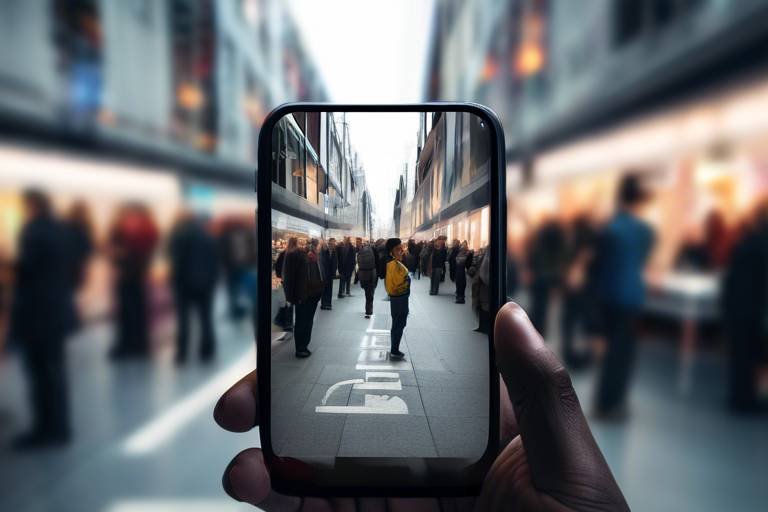Innovations in Data Collection through Mobile Applications
In today’s fast-paced digital landscape, the way we collect data has undergone a remarkable transformation, largely driven by the innovations in mobile applications. These advancements are not just about convenience; they are revolutionizing how businesses operate, enhance customer experiences, and make informed decisions. Imagine a world where data flows seamlessly, where insights are gathered at the speed of light, and where every interaction can be measured and analyzed in real-time. This is the promise of modern mobile applications, which combine cutting-edge technology with user-friendly interfaces to create a new paradigm for data collection.
From healthcare to retail, the impact of these innovations is profound. Mobile applications are now equipped with sophisticated features like GPS tracking, real-time analytics, and user-friendly interfaces that make data collection not only easier but also more reliable. These tools allow businesses to gather vast amounts of information with unprecedented accuracy and efficiency. For instance, consider a healthcare app that tracks patient symptoms and provides doctors with real-time updates. This not only improves patient care but also enhances the overall efficiency of healthcare delivery. The ability to collect data on-the-go means that organizations can adapt quickly to changing circumstances, making informed decisions that propel them forward.
Moreover, the accessibility of mobile applications has democratized data collection. No longer confined to the realm of large corporations, small businesses and startups can now leverage these tools to gather insights that were once out of reach. This shift not only levels the playing field but also encourages innovation across various sectors. With mobile data collection, businesses can tap into customer feedback instantly, allowing them to refine their products and services based on real user experiences. This agility is crucial in a competitive market where consumer preferences can shift overnight.
As we delve deeper into this topic, we will explore the specific advancements in mobile technology, the benefits of real-time data collection, and the challenges that organizations face in implementing these solutions. We will also highlight case studies that illustrate the successful application of mobile data collection across different industries. By understanding these dynamics, businesses can harness the full potential of mobile applications to drive growth and improve operational efficiency.

Advancements in Mobile Technology
Mobile technology has undergone a remarkable transformation over the past decade, becoming a cornerstone of modern data collection methods. With the advent of smartphones and tablets, we now have powerful tools at our fingertips that can capture, process, and analyze data in real-time. The integration of advanced hardware components, such as high-resolution cameras, GPS sensors, and biometric scanners, has dramatically improved the way we collect data. Imagine being able to scan a product's barcode, capture customer feedback, and track inventory levels all from a single mobile device!
On the software side, innovations in mobile applications have paved the way for more efficient data gathering processes. For instance, the development of cloud computing allows users to store and access data from anywhere, making it easier than ever to collaborate on projects and share insights across teams. Additionally, the rise of artificial intelligence (AI) and machine learning has enabled mobile applications to analyze data patterns and provide actionable insights in real-time. This capability not only enhances the accuracy of data collection but also empowers organizations to make informed decisions quickly.
Furthermore, the introduction of 5G technology has revolutionized mobile data collection by providing faster data transfer speeds and lower latency. This means that businesses can now upload and analyze large datasets almost instantaneously, leading to quicker response times and improved operational efficiency. In industries like healthcare, where timely data can mean the difference between life and death, these advancements are nothing short of groundbreaking.
To illustrate these advancements, let's take a look at a table comparing traditional data collection methods with modern mobile technology:
| Aspect | Traditional Methods | Mobile Technology |
|---|---|---|
| Speed | Slow data entry and processing | Real-time data collection and analysis |
| Accuracy | Prone to human error | Enhanced accuracy through automated processes |
| Accessibility | Limited to specific locations | Accessible from anywhere with an internet connection |
| Collaboration | Difficult to share data | Instant sharing and collaboration capabilities |
In summary, the advancements in mobile technology are not just incremental improvements; they represent a paradigm shift in how we approach data collection. As these technologies continue to evolve, we can expect even more innovative solutions that will further enhance our ability to gather and utilize data effectively. Whether you're in healthcare, marketing, or any other industry, embracing these advancements can lead to significant improvements in productivity and decision-making.

Real-Time Data Collection
In today's fast-paced world, the ability to gather and analyze data in real-time has become a game changer for businesses across various sectors. Imagine being able to make decisions based on the latest information at your fingertips! Real-time data collection allows organizations to tap into a wealth of information as it happens, leading to quicker responses and more informed strategies. This capability is particularly beneficial in industries such as healthcare and marketing, where timing can be everything.
One of the most significant advantages of real-time data collection is its ability to enhance operational efficiency. For instance, in healthcare, doctors can monitor patient vitals continuously, receiving alerts on any changes that require immediate attention. This not only improves patient outcomes but also optimizes resource allocation within hospitals. Similarly, in marketing, companies can track consumer behavior in real-time, allowing them to adjust campaigns on the fly based on what resonates with their audience.
Furthermore, the applications of real-time data collection are vast. Businesses can leverage this technology to:
- Monitor social media interactions and trends as they unfold.
- Conduct instant surveys and feedback sessions with customers.
- Track inventory levels and sales in real-time for better supply chain management.
The ability to access data instantly not only streamlines processes but also fosters a culture of agility within organizations. Companies that embrace real-time data collection can pivot quickly in response to market changes, ensuring they remain competitive. However, this immediacy comes with its own set of challenges, which we will explore in the next sections.
Having immediate access to data transforms decision-making processes within organizations. Imagine a marketing team analyzing customer engagement metrics during a live campaign; they can make adjustments to their strategy on the spot, optimizing their efforts based on what the data reveals. This kind of agility is invaluable in a marketplace where consumer preferences can shift rapidly.
Additionally, real-time data collection allows businesses to identify trends and patterns that might otherwise go unnoticed. For example, by analyzing real-time sales data, a retailer can quickly determine which products are flying off the shelves and which are lagging behind. This insight enables them to make strategic decisions about inventory, promotions, and even product development.
To illustrate the power of real-time data collection, let’s consider a few case studies from different industries:
| Industry | Company | Application of Real-Time Data | Outcome |
|---|---|---|---|
| Healthcare | HealthTech Corp | Monitoring patient vitals | Improved patient outcomes and reduced emergency response times |
| Retail | ShopSmart | Real-time inventory tracking | Increased sales and reduced stockouts |
| Marketing | AdVenture | Live campaign adjustments | Enhanced customer engagement and higher conversion rates |
These examples highlight how different sectors are harnessing the power of real-time data to drive improvements and achieve better outcomes.
Despite its numerous advantages, real-time data collection is not without challenges. Organizations may face issues such as data overload, where the sheer volume of incoming information becomes overwhelming. Additionally, ensuring data accuracy and reliability can be difficult, especially when integrating data from multiple sources.
To address these challenges, companies can implement strategies such as:
- Utilizing advanced analytics tools that filter and prioritize data.
- Establishing clear protocols for data collection and validation.
- Investing in training for staff to effectively interpret and act on data insights.
By proactively addressing these challenges, organizations can fully leverage the benefits of real-time data collection, leading to better decision-making and enhanced operational efficiency.

Impact on Decision Making
The advent of real-time data collection through mobile applications has transformed the landscape of decision-making across various industries. Imagine being a ship captain navigating through foggy waters; having a precise map and real-time weather updates can make the difference between a smooth journey and a disastrous crash. Similarly, organizations today are leveraging instant data insights to steer their operations more effectively.
With immediate access to data, businesses can respond to market changes swiftly. For instance, in the retail sector, real-time sales data can help store managers adjust inventory levels on the fly, ensuring that popular products are always in stock while minimizing overstock on less popular items. This level of responsiveness can significantly enhance customer satisfaction and boost sales.
Moreover, real-time data collection empowers teams to make informed decisions based on accurate and current information. In healthcare, for example, medical professionals can monitor patient vitals continuously and make critical decisions without delay. This immediacy not only improves patient outcomes but also enhances operational efficiency by reducing unnecessary tests and procedures.
To illustrate the impact of real-time data on decision-making, consider the following table that highlights key benefits across different sectors:
| Industry | Benefits of Real-Time Data | Examples |
|---|---|---|
| Healthcare | Improved patient monitoring, timely interventions | Remote patient monitoring systems |
| Retail | Dynamic inventory management, enhanced customer experience | Point-of-sale systems with real-time analytics |
| Marketing | Targeted campaigns, real-time customer feedback | Social media analytics tools |
Furthermore, the integration of real-time data into decision-making processes fosters a culture of agility within organizations. Teams become more adaptive, allowing them to pivot quickly in response to new challenges or opportunities. This shift not only enhances operational efficiency but also cultivates a proactive mindset among employees.
However, it’s essential to recognize that while real-time data offers immense advantages, it also requires a robust framework for analysis and interpretation. Organizations must invest in training their teams to understand and utilize this data effectively. After all, data is only as valuable as the insights it generates. Thus, the ability to translate raw data into actionable strategies is what truly drives superior decision-making.
In conclusion, the impact of real-time data collection on decision-making is profound. By harnessing the power of immediate insights, organizations can navigate their respective markets with confidence and precision, ultimately leading to enhanced performance and success.
- What is real-time data collection? Real-time data collection refers to the process of gathering and analyzing information instantaneously, allowing businesses to make immediate decisions based on current data.
- How does real-time data impact decision-making? It enhances decision-making by providing timely insights, enabling organizations to respond quickly to changes and improve operational efficiency.
- What industries benefit the most from real-time data collection? Industries such as healthcare, retail, and marketing significantly benefit from real-time data collection due to their need for quick, informed decisions.

Case Studies in Industry
When it comes to real-time data collection through mobile applications, several industries have made remarkable strides. These case studies not only highlight the effectiveness of these innovations but also showcase how organizations have transformed their operations. Let's dive into some compelling examples that illustrate the impact of mobile data collection.
One notable case is in the healthcare sector. A leading hospital network implemented a mobile application designed to collect patient feedback in real-time. By utilizing this app, they managed to gather data on patient satisfaction immediately after discharge. This allowed healthcare providers to address concerns promptly, improving overall patient care. The result? A staggering 20% increase in patient satisfaction scores within just six months. This case exemplifies how mobile applications can facilitate immediate feedback loops, enabling healthcare professionals to make swift adjustments to their services.
Another fascinating example comes from the retail industry. A well-known clothing brand launched a mobile app that not only serves as a shopping platform but also collects data on customer preferences and shopping behaviors. By integrating real-time analytics, the brand could tailor promotions and inventory based on live customer interactions. This strategy led to a remarkable 15% boost in sales during peak seasons, as the brand could respond to consumer trends almost instantaneously. This case highlights the power of mobile applications in creating a personalized shopping experience, which is crucial in today’s competitive market.
In the realm of agriculture, a progressive farm management company adopted a mobile data collection system to monitor crop health and yield in real-time. By equipping farmers with mobile devices that track weather patterns, soil conditions, and crop growth, they were able to make informed decisions on irrigation and harvesting. The impact was profound, with farmers reporting an impressive 30% increase in crop yield due to timely interventions. This case underscores how mobile applications can revolutionize traditional practices, making agriculture more efficient and sustainable.
Moreover, the transportation sector has also benefitted from real-time data collection. A logistics company implemented a mobile app that tracks delivery vehicles and provides real-time updates to customers. This not only improved customer satisfaction but also optimized route planning, reducing fuel costs by 25%. The combination of immediate tracking and data analytics enabled the company to enhance operational efficiency significantly, demonstrating the multifaceted benefits of mobile data collection.
As we can see from these case studies, the integration of mobile applications in various sectors has led to improved operational efficiencies, enhanced customer satisfaction, and increased profitability. The key takeaway is that real-time data collection is not just a trend; it is a transformative approach that can drive significant change across industries.
- What is real-time data collection? Real-time data collection refers to the process of gathering and analyzing data instantly as it becomes available, allowing for immediate insights and actions.
- How can mobile applications enhance data collection? Mobile applications can streamline the data collection process by enabling users to input information quickly, access data on-the-go, and receive real-time updates and analytics.
- What industries can benefit from mobile data collection? Various industries, including healthcare, retail, agriculture, and transportation, can leverage mobile data collection to improve efficiency and decision-making.
- What are the challenges of implementing mobile data collection? Challenges include data privacy concerns, the need for user training, and ensuring the technology is reliable and user-friendly.

Challenges and Solutions
Even though the advantages of real-time data collection through mobile applications are numerous, it's important to recognize the challenges that come along with it. One of the most prevalent issues is the accuracy of data. If users are inputting information on the go, there’s a risk of human error, which can lead to unreliable data. For instance, a healthcare worker might misrecord a patient’s vital signs due to distractions in a busy environment. To mitigate this, implementing validation checks within the application can help ensure that the data entered meets certain criteria before it is submitted.
Another significant challenge is network connectivity. Many mobile applications rely heavily on internet access to sync data in real-time. In remote areas or places with poor connectivity, this can pose a serious problem, leading to delays or loss of information. To address this, developers are increasingly adopting offline capabilities in their apps, allowing users to collect data without an internet connection and sync it later when connectivity is restored.
Moreover, user engagement can be a double-edged sword. While some users may be enthusiastic about using mobile applications for data collection, others may feel overwhelmed or uninterested. It’s crucial to design applications that are not only functional but also engaging. Techniques such as personalized notifications and user-friendly interfaces can significantly enhance user experience and encourage consistent participation.
Finally, there’s the ever-looming issue of data privacy and security. With the increasing amount of sensitive information being collected, ensuring that this data is protected against breaches is paramount. Organizations must invest in robust security measures, including encryption and regular audits, to safeguard user data. Additionally, educating users about how their data will be used and the measures in place to protect it can foster trust and encourage more individuals to participate in data collection initiatives.
In summary, while the challenges of real-time data collection through mobile applications are significant, they are not insurmountable. By implementing effective solutions such as validation checks, offline capabilities, engaging designs, and stringent security measures, organizations can enhance the efficacy of their data collection efforts and ultimately drive better outcomes.
- What are the main challenges of mobile data collection?
Some of the main challenges include data accuracy, network connectivity, user engagement, and data privacy and security. - How can organizations improve data accuracy?
Implementing validation checks and training users can significantly enhance data accuracy. - What solutions are available for network connectivity issues?
Developing mobile apps with offline capabilities allows users to collect data without internet access and sync later. - How important is user engagement in data collection?
User engagement is crucial as it directly impacts the quality and quantity of data collected. - What measures can be taken to ensure data security?
Organizations should invest in encryption, regular audits, and user education to protect sensitive information.

Data Privacy and Security
In today's digital age, the importance of data privacy and security cannot be overstated, especially with the rise of mobile applications that facilitate data collection. As businesses increasingly rely on mobile technology to gather sensitive information, the risks associated with data breaches and unauthorized access have escalated dramatically. Mobile applications are often targeted by cybercriminals looking to exploit vulnerabilities, making it crucial for developers and organizations to prioritize the protection of user data.
When we think about the information that mobile apps collect, it ranges from basic personal details to highly sensitive data such as health records and financial information. Therefore, ensuring that this data is not only collected but also stored and transmitted securely is a top priority. Organizations must adhere to strict regulations such as the General Data Protection Regulation (GDPR) and the Health Insurance Portability and Accountability Act (HIPAA), which set clear guidelines on how personal data should be handled.
One of the primary challenges in maintaining data privacy is the balance between usability and security. Users often prefer convenience, which can lead to the use of weak passwords or the sharing of sensitive information on unsecured networks. To combat this, developers can implement various security measures, including:
- Data Encryption: Encrypting data both at rest and in transit ensures that even if data is intercepted, it remains unreadable to unauthorized parties.
- Multi-Factor Authentication (MFA): Requiring multiple forms of verification before granting access can significantly reduce the risk of unauthorized access.
- Regular Security Audits: Conducting audits to identify vulnerabilities within mobile applications can help organizations stay ahead of potential threats.
Moreover, educating users about the importance of data privacy and encouraging them to adopt safe practices can further enhance security. For instance, users should be advised to:
- Use strong, unique passwords for different applications.
- Be cautious when granting permissions to apps, especially those requesting access to sensitive information.
- Regularly update their apps to benefit from the latest security patches.
In conclusion, while mobile applications offer unparalleled opportunities for data collection and analysis, they also present significant challenges regarding data privacy and security. By implementing robust security measures, adhering to regulations, and promoting user awareness, organizations can protect user data effectively. This not only fosters trust but also enhances the overall effectiveness of data collection processes, paving the way for innovative applications that respect user privacy.
1. What are the common security threats to mobile applications?
Common threats include data breaches, malware attacks, and unauthorized access to sensitive information.
2. How can I ensure my data is secure when using mobile apps?
Use apps that offer encryption, enable multi-factor authentication, and avoid sharing sensitive information over unsecured networks.
3. What regulations should mobile app developers be aware of?
Developers should be familiar with GDPR, HIPAA, and other regional data protection laws that govern user data handling.
4. How often should I update my mobile applications?
Regular updates are essential; you should update your apps as soon as new versions are available to ensure you have the latest security features.

User Experience and Engagement
When it comes to mobile applications, user experience (UX) is not just a buzzword—it's a critical factor that determines the success of any data collection initiative. Imagine walking into a store where the layout is confusing, and the staff is unhelpful; you’d likely leave without making a purchase, right? The same principle applies to mobile apps. If users find the interface clunky or the navigation frustrating, they’ll quickly abandon the app, leading to lost data and wasted resources. Therefore, enhancing user experience is paramount for effective data gathering.
One of the key aspects of user experience is intuitive design. A well-designed mobile application should feel natural to use, almost like an extension of the user's hand. This means that buttons should be easily accessible, information should be logically organized, and feedback should be immediate. For instance, when a user submits data, they should receive a confirmation message promptly, reassuring them that their input has been recorded. This kind of responsiveness not only boosts user confidence but also encourages them to engage more frequently with the app.
Moreover, user engagement is equally important. An engaged user is more likely to provide accurate and timely data. One effective way to enhance engagement is through the use of gamification techniques. By incorporating game-like elements—such as points, badges, and leaderboards—mobile applications can motivate users to participate actively in data collection. For example, a health app might reward users with points for logging their meals or completing fitness challenges, creating a sense of achievement and competition that drives ongoing participation.
To illustrate, consider a mobile application designed for environmental data collection. Users can earn badges for submitting reports on air quality or participating in community clean-up events. This not only makes the process enjoyable but also fosters a sense of community among users, as they can compare their achievements and encourage one another. Hence, gamification can be a powerful tool for increasing user engagement and ensuring that data collection is not just a task, but an enjoyable experience.
In addition to intuitive design and gamification, it's essential to conduct regular user testing. This involves gathering feedback from real users about their experiences with the app. By understanding their pain points and preferences, developers can make informed enhancements that align with user expectations. A mobile app that evolves based on user feedback is more likely to retain its audience and optimize data collection efforts.
Ultimately, the goal of enhancing user experience and engagement is to create a seamless and enjoyable data collection process. When users feel valued and their input is acknowledged, they are more likely to contribute consistently. As mobile applications continue to play a pivotal role in data collection across various industries, prioritizing user experience will not only improve data accuracy but also foster a loyal user base.
- What is user experience in mobile applications?
User experience refers to how a user interacts with and experiences a mobile application, including its usability, accessibility, and overall satisfaction. - How can gamification improve user engagement?
Gamification incorporates game-like elements into non-game contexts, making tasks more enjoyable and motivating users to participate actively. - Why is user feedback important in app development?
User feedback helps developers identify issues and improve the app based on real user experiences, leading to better usability and satisfaction.

Design Principles for Mobile Apps
When it comes to creating mobile applications, design principles play a critical role in ensuring that users not only engage with the app but also find it easy to use. Imagine walking into a store where everything is laid out perfectly—each item is easy to find, and the atmosphere invites you to explore. This is the kind of experience a well-designed mobile app should provide. The key is to focus on usability, accessibility, and visual appeal.
First and foremost, the principle of usability cannot be overstated. Users should be able to navigate through the app effortlessly. This means that buttons should be large enough to tap easily, and the layout should be intuitive. For instance, if you’re developing a data collection app, make sure that fields for input are clearly labeled and that users can easily understand what information is required. A good rule of thumb is to conduct user testing; gather feedback and make adjustments accordingly. This iterative process is like fine-tuning a musical instrument—each tweak brings you closer to the perfect harmony.
Next, let’s talk about accessibility. In today's diverse world, your app should be usable by everyone, including those with disabilities. This means incorporating features such as voice input, screen readers, and high-contrast visuals. Think of accessibility as a bridge that connects your app to a wider audience. If your app is easy to use for people with varying abilities, you not only enhance user experience but also expand your potential user base significantly.
Visual appeal is another crucial design principle. Aesthetics matter! A visually pleasing app can captivate users and encourage them to return. Use color schemes that are easy on the eyes and ensure that your typography is readable. For example, a study showed that apps with consistent branding and color palettes saw a 30% increase in user retention. It’s like dressing your app in a stylish outfit that makes it stand out in a crowded room.
Furthermore, consider incorporating feedback mechanisms within the app. Users should receive immediate responses to their actions, whether it’s a subtle animation when they tap a button or a notification confirming that their data has been successfully submitted. This not only reassures users that their actions have been recognized but also keeps them engaged. Imagine playing a video game where every move you make is met with a satisfying response; that’s the kind of interaction users appreciate in mobile apps.
Lastly, let’s not forget about the importance of simplicity. In a world where users are bombarded with information, a clutter-free design is refreshing. Aim for a minimalistic approach that highlights essential features without overwhelming the user. A well-structured layout that prioritizes the most important functions can significantly enhance the user experience. Think of it as decluttering your home—when everything has its place, it’s easier to find what you need.
In summary, the design principles for mobile apps revolve around creating an engaging, accessible, and visually appealing experience that prioritizes usability and simplicity. By focusing on these key aspects, developers can ensure that their applications not only attract users but also retain them in the long run.
- What are the key design principles for mobile apps? - The key principles include usability, accessibility, visual appeal, feedback mechanisms, and simplicity.
- How can I improve the usability of my app? - Conduct user testing to gather feedback, ensure intuitive navigation, and make buttons easy to tap.
- Why is accessibility important in mobile app design? - Accessibility ensures that your app can be used by a wider audience, including those with disabilities, thus expanding your user base.
- How does visual appeal affect user retention? - A visually pleasing app can captivate users, encouraging them to return and engage more frequently.

Gamification Techniques
In today's digital landscape, gamification has emerged as a powerful tool to enhance user engagement, especially in mobile data collection applications. Imagine turning a mundane task into an exciting challenge—this is precisely what gamification achieves. By incorporating game-like elements into applications, developers can motivate users to participate more actively in data gathering processes. But how does this work, and why is it so effective?
At its core, gamification taps into our natural instincts for competition, achievement, and social interaction. When users are presented with challenges, rewards, and the opportunity to compare their performance with others, they are more likely to engage deeply with the application. For instance, consider a mobile app designed for health data collection. By integrating features such as points, badges, and leaderboards, users are incentivized to input their health metrics regularly, turning a simple task into a fun game.
One effective technique is the use of points systems. Users earn points for completing tasks, such as filling out surveys or logging data. This not only encourages participation but also provides a sense of accomplishment. Moreover, these points can be linked to tangible rewards, such as discounts or exclusive content, further enhancing motivation. A recent study showed that apps utilizing points systems saw a 30% increase in user engagement compared to those that did not.
Another popular technique is the implementation of badges. Badges serve as visual representations of achievements, allowing users to showcase their progress. For example, a user might earn a badge after completing their first week of daily check-ins. This not only boosts the user's morale but also fosters a sense of community when users can share their achievements with friends or fellow users.
Leaderboards can also play a significant role in gamification. By displaying user rankings based on their activity or data contributions, apps create a competitive environment. This can lead to increased participation, as users strive to improve their standings. However, it’s essential to ensure that the competition remains friendly and inclusive, so that it appeals to a broad audience rather than discouraging those who may not be as competitive.
To illustrate the effectiveness of these gamification techniques, let's take a look at a case study involving a mobile application aimed at collecting environmental data. The app implemented a points system, badges for milestones, and a leaderboard to track user contributions. As a result, the app experienced a remarkable 50% increase in user participation within just three months. Users reported feeling more connected to their contributions, leading to a higher quality of data collected.
However, it's crucial to strike a balance with gamification. Overdoing it can lead to user fatigue or frustration, especially if the challenges feel too daunting or the rewards seem unattainable. Therefore, developers must continuously assess user feedback and adjust the gamification elements accordingly to maintain engagement without overwhelming users.
In conclusion, gamification techniques have the potential to transform mobile data collection applications into engaging platforms that not only gather valuable information but also enhance user experience. By leveraging points systems, badges, and leaderboards, developers can create an environment that encourages participation while making the process enjoyable. As we move forward, embracing these techniques will be essential for maximizing user engagement and achieving more accurate data collection outcomes.
- What is gamification? Gamification is the application of game-design elements and principles in non-game contexts to enhance user engagement and motivation.
- How does gamification improve data collection? By making data collection tasks more engaging through points, badges, and leaderboards, users are more likely to participate actively.
- Are there any downsides to gamification? Yes, if overused, gamification can lead to user fatigue or frustration. It's important to find the right balance.
- Can gamification be used in any industry? Absolutely! Gamification can be applied in various sectors, including healthcare, education, and marketing, to enhance user engagement.
Frequently Asked Questions
- What are the key advancements in mobile technology for data collection?
The latest advancements in mobile technology include improved hardware such as high-resolution cameras, sensors, and GPS capabilities, along with sophisticated software that supports data analytics and machine learning. These innovations allow for more accurate and efficient data gathering, making mobile applications a vital tool across various industries.
- How does real-time data collection benefit businesses?
Real-time data collection enables businesses to gather and analyze information instantly, leading to quicker decision-making and enhanced operational efficiency. For instance, in healthcare, immediate access to patient data can significantly improve treatment outcomes, while in marketing, real-time insights can help tailor campaigns to consumer behavior.
- What challenges are associated with real-time data collection?
Despite its advantages, real-time data collection can face challenges such as data overload, integration issues with existing systems, and maintaining data accuracy. However, these challenges can be addressed through proper training, using advanced analytics tools, and establishing clear data governance policies.
- How important is data privacy and security in mobile applications?
Data privacy and security are paramount in mobile applications, especially with the rise of data collection. Protecting user data and complying with regulations like GDPR is essential to maintain user trust and avoid legal repercussions. Developers must implement robust security measures and transparent data handling practices.
- What design principles enhance user experience in mobile data collection apps?
Effective design principles that enhance user experience include intuitive navigation, clear call-to-action buttons, and responsive layouts that adapt to different screen sizes. A user-friendly interface encourages users to engage more with the application, ultimately improving the data collection process.
- How can gamification techniques improve user engagement?
Gamification techniques, such as rewards, challenges, and leaderboards, can significantly boost user engagement by making the data collection process more enjoyable and interactive. By incorporating game-like elements, users are more likely to participate actively and consistently, leading to better data quality and quantity.



















